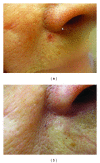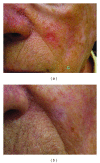Treatment of Basal cell carcinomas with pulsed dye laser: a case series
- PMID: 23316366
- PMCID: PMC3532878
- DOI: 10.1155/2012/286480
Treatment of Basal cell carcinomas with pulsed dye laser: a case series
Abstract
Background. Basal cell carcinoma (BCC) is the most prevalent skin cancer. Because of its highly vascular characteristic, it is amendable to treatment with pulse dye laser (PDL). The goal of this study is to determine the safety and efficacy of PDL therapy for mostly facial BCCs. Materials and Methods. Sixteen men and thirteen women (29 total) with 39 biopsy-proven BCCs were treated with 1-4 PDL (595 nm) therapies at 2-4-week intervals. The treatment parameters included pulse energy of 15 J/cm 2, pulse length of 3 millisecond, with no dynamic cooling, and 7 mm spot size. The age of the patients was 30-90 years (mean 73 years). Response rates were evaluated by the clinical assessments with mean followup of 11 months. Results. Twenty-four patients with thirty-two tumors reached at least three months followup: 24/32 (75%) tumors with complete resolution (mean 3 treatment sessions); 5/32 (16%) tumors recurred; 3/32 (9%) tumors with incomplete responses after four treatments. Minimal side effects and discomfort were experienced by the patients with PDL therapy. Conclusion. PDL is a safe, tolerable, and moderately effective method of treating various BCCs. The ideal niche and standardized settings for PDL treatment of BCCs are yet to be determined.
Figures




Similar articles
-
The effect of 595 nm pulsed dye laser on superficial and nodular basal cell carcinomas.Lasers Surg Med. 2009 Aug;41(6):417-22. doi: 10.1002/lsm.20787. Lasers Surg Med. 2009. PMID: 19588534 Clinical Trial.
-
Single treatment of non-melanoma skin cancers using a pulsed-dye laser with stacked pulses.Lasers Surg Med. 2012 Aug;44(6):459-67. doi: 10.1002/lsm.22032. Epub 2012 Apr 17. Lasers Surg Med. 2012. PMID: 22511036 Clinical Trial.
-
Combined 585 nm pulsed-dye and 1,064 nm Nd:YAG lasers for the treatment of basal cell carcinoma.Lasers Surg Med. 2014 Jan;46(1):1-7. doi: 10.1002/lsm.22201. Epub 2013 Nov 23. Lasers Surg Med. 2014. PMID: 24272664 Clinical Trial.
-
Single treatment of low-risk basal cell carcinomas with pulsed dye laser-mediated photodynamic therapy (PDL-PDT) compared with photodynamic therapy (PDT): A controlled, investigator-blinded, intra-individual prospective study.Photodiagnosis Photodyn Ther. 2016 Dec;16:60-65. doi: 10.1016/j.pdpdt.2016.08.003. Epub 2016 Aug 8. Photodiagnosis Photodyn Ther. 2016. PMID: 27516420 Clinical Trial.
-
Retrospective analysis of the treatment of melasma lesions exhibiting increased vascularity with the 595-nm pulsed dye laser combined with the 1927-nm fractional low-powered diode laser.Lasers Surg Med. 2017 Jan;49(1):20-26. doi: 10.1002/lsm.22518. Epub 2016 Apr 13. Lasers Surg Med. 2017. PMID: 28134994 Review.
Cited by
-
Pulsed Dye Laser for Treatment of Basal Cell Carcinoma.Plast Reconstr Surg Glob Open. 2023 Mar 6;11(3):e4850. doi: 10.1097/GOX.0000000000004850. eCollection 2023 Mar. Plast Reconstr Surg Glob Open. 2023. PMID: 36891564 Free PMC article.
-
Fragile hands: targeting nonmelanoma skin cancer on older hands using 595 nm pulsed dye laser.Lasers Med Sci. 2024 Apr 17;39(1):101. doi: 10.1007/s10103-024-04047-6. Lasers Med Sci. 2024. PMID: 38630146
-
Treatment of Basal Cell Cancer With a Pulsed Copper Vapor Laser: A Case Series.J Lasers Med Sci. 2019 Fall;10(4):350-354. doi: 10.15171/jlms.2019.57. Epub 2019 Oct 1. J Lasers Med Sci. 2019. PMID: 31875131 Free PMC article.
-
Abscopal Effects and Immunomodulation in Skin Cancer Therapy.Am J Clin Dermatol. 2025 Jul;26(4):555-585. doi: 10.1007/s40257-025-00943-x. Epub 2025 Apr 3. Am J Clin Dermatol. 2025. PMID: 40180765 Review.
-
The effect of pulsed dye laser on high-risk basal cell carcinomas with response control by Mohs micrographic surgery.Lasers Med Sci. 2015 Sep;30(7):2009-14. doi: 10.1007/s10103-014-1686-1. Epub 2014 Oct 31. Lasers Med Sci. 2015. PMID: 25359622
References
-
- Arora A, Attwood J. Common skin cancers and their precursors. Surgical Clinics of North America. 2009;89(3):703–712. - PubMed
-
- Tierney EP, Hanke CW. Cost effectiveness of Mohs micrographic surgery: review of the literature. Journal of Drugs in Dermatology. 2009;8(10):914–922. - PubMed
-
- Shah SM, Konnikov N, Duncan LM, Tannous ZS. The effect of 595 nm pulsed dye laser on superficial and nodular basal cell carcinomas. Lasers in Surgery and Medicine. 2009;41(6):417–422. - PubMed
-
- Campolmi P, Troiano M, Bonan P, Cannarozzo G, Lotti T. Vascular based non conventional dye laser treatment for basal cell carcinoma. Dermatologic Therapy. 2008;21(5):402–405. - PubMed
LinkOut - more resources
Full Text Sources

